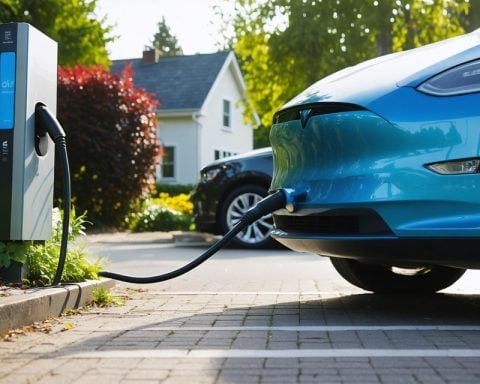- Faraday Future’s FX 6 prototypes start testing in the U.S., aiming to revolutionize EV affordability.
- Massimo Motor Sports shifts golf cart production back to the U.S., boosting local economies and quality.
- XCharge North America’s partnership with Orlando Utilities Commission introduces a resilient, cost-effective EV charger.
- Zerova and Go Eve innovate with a rapid sequential charging solution for workplaces and public spaces.
- Toyota’s third-generation fuel cell system offers double durability, promoting hydrogen as a key transport solution.
- KULR and Worksport collaborate to enhance battery technology and American-made energy solutions.
- The EV industry’s advancements underscore a collective shift towards sustainability and transportation reimagination.
In an ever-evolving landscape of electric vehicles and charging innovations, industry trailblazers are painting the roads of tomorrow in vibrant green hues. These advancements signify not just technological progress but also a shift towards a more sustainable future.
In a bold step, Faraday Future propels its FX 6 prototype mules from China to the U.S., marking a new chapter in its electric vehicle saga. This move signals the beginning of extensive testing on cutting-edge features like autonomous driving at its California base, with ambitions to redefine affordability in the EV market.
Meanwhile, Massimo Motor Sports returns its golf cart production to American soil, a strategic maneuver to bolster quality and streamline operations. This move promises enhanced oversight and efficiency, alongside a boon for local economies and the assurance of higher performance in eco-friendly vehicles.
In the realm of charging solutions, XCharge North America partners with Orlando Utilities Commission, unveiling a groundbreaking charger that strengthens grid resilience while slashing infrastructure costs. Their innovation, equipped to deliver robust energy even in hurricanes, sets new standards for reliability in EV charging.
Zerova and Go Eve disrupt conventional charging with their partnership. By blending rapid charging with sequential technology, they offer a practical and efficient solution that redefines how workplaces and public spaces approach EV infrastructure.
Toyota impresses with its third-generation fuel cell system, elevating hydrogen into the limelight. Promising double the durability and a sleeker design, this system is poised to revolutionize transportation across continents.
In the pursuit of enhanced battery technology, KULR and Worksport join forces, heralding an era of smarter, safer energy storage solutions, and supporting the burgeoning market for American-made energy solutions.
These developments chart a dynamic course for green mobility, showcasing an industry united in its drive towards a sustainable future. With these strides, the electric vehicle ecosystem is not just evolving—it’s reimagining the very way we think about transportation.
Discover the Future: How Electric Vehicles and Charging Technologies are Shaping Tomorrow
How-To Steps & Life Hacks for Adopting Electric Vehicles
1. Evaluate Your Driving Needs: Assess how far you typically drive daily and how this aligns with the range of available electric vehicles (EVs). Consider the charging infrastructure in your area.
2. Understand Charging Options: Familiarize yourself with the different types of EV chargers. Level 1 chargers are standard for home use but charge slowly. Level 2 chargers are faster and ideal for home installation if you drive frequently.
3. Explore Incentives and Rebates: Many governments offer tax benefits, rebates, or incentives for EV purchases and home charging installations. Check your local and federal resources to capitalize on these support options.
4. Plan for Long Trips: Use apps like PlugShare and ChargePoint to plan long-distance trips, locating charging stations along your route.
Real-World Use Cases & Industry Trends
– Faraday Future: The FX 6 is poised to make luxury more affordable in the EV space, targeting a broader market by offering competitive pricing indicative of a trend towards democratized EV ownership.
– Massimo Motor Sports’ Local Production: By moving manufacturing back to the U.S., the brand improves quality control and reduces supply chain risks, reflecting a trend of reshoring to enhance product reliability.
Controversies & Limitations
– Autonomous Driving: Despite advancements, autonomous driving technology has faced skepticism due to safety and regulatory concerns. The tech in Faraday Future vehicles must pass rigorous regulatory environments.
– Hydrogen Fuel Cell Technology: While Toyota’s fuel cells promise breakthroughs, hydrogen infrastructure remains limited compared to EV charging, posing a barrier to widespread adoption.
Features, Specs & Pricing
– Hydrogen Fuel Cells: Toyota’s third-gen system offers double the durability and reduced size, indicating a shift toward more compact and efficient designs.
– FX 6 Prototype: Faraday Future aims to integrate autonomous driving capabilities, though specifics on range and pricing remain speculative pending further testing.
Security & Sustainability
– Charger Resilience: XCharge’s hurricane-proof charging solution emphasizes the need for secure, stable grid integration, vital for areas prone to natural disasters.
Reviews & Comparisons
– EV Charging Solutions: Zerova and Go Eve’s rapid charging tech benefits workplaces and public areas but requires careful site assessment to maximize efficiency and effectiveness over traditional methods.
Pros & Cons Overview
– Pros:
– For EV Owners: Reduced fueling costs, fewer emissions, diverse models to suit various lifestyles.
– For Manufacturers: Branding associated with sustainability attracts eco-conscious consumers.
– Cons:
– Infrastructure Challenges: Not all areas have robust EV infrastructure; development lags behind demand.
– Initial Costs: High initial purchase price unless adequately subsidized.
Actionable Recommendations
1. Stay Informed: Regularly update yourself on evolving EV technologies to make informed purchasing decisions when the time comes.
2. Support Local Production: Choosing products made locally can enhance quality and boost economic benefits in your community.
3. Utilize Charging Apps: Incorporate technology like EV trip planners to mitigate range anxiety and optimize your driving experience.
4. Advocate for Infrastructure: Encourage local government and businesses to expand charging networks, ensuring sustainable growth in EV adoption.
For further insights on electric vehicles and renewable energy development, visit Tesla or Toyota.













